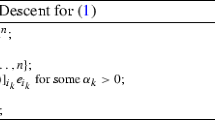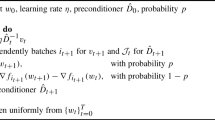Abstract
Marr and Poggio (1976) recently described a cooperative algorithm that solves the correspondence problem for stereopsis. This article uses a probabilistic technique to analyze the convergence of that algorithm, and derives the conditions governing the stability of the solution state. The actual results of applying the algorithm to random-dot stereograms are compared with the probabilistic analysis. A satisfactory mathematical analysis of the asymptotic behaviour of the algorithm is possible for a suitable choice of the parameter values and loading rules, and again the actual performance of the algorithm under these conditions is compared with the theoretical predictions. Finally, some problems raised by the analysis of this type of “cooperative” algorithm are briefly discussed.
Similar content being viewed by others
References
Eigen, M.: Self-organization of matter and the evolution of biological macromolecules. Naturwissenschaften 10, 465–523 (1971)
Haken, H.: Synergetics. Berlin-Heidelberg-New York: Springer 1977
Kawasaki, K.: Kinetics of Ising models. In: Phase transitions and critical phenomena, Vol. 2, pp. 443–501. Domb and Green eds., New York: Academic Press 1972
Marr, D.: Simple memory: s theory for archicortex. Phil. Trans. Roy. Soc. B 262, 23–81 (1971)
Marr, D.: A note on the computation of binocular disparity in a symbolic, low-level visual processor. M.I.T. A.I. Lab. Memo 327, (1974)
Marr, D.: Early processing of visual information. Phil. Trans. Roy. Soc. B 275, 483–524 (1976)
Marr, D.: Representing visual information. AAAS 143rd Annual Meeting, Symposium on Some Mathematical Questions in Biology, February, (in press). Also available as M.I.T. A.I. Lab. Memo 415 (1977)
Marr, D., Poggio, T.: Cooperative computation of stereo disparity. Science 194, 283–287 (1976)
Mostow. Mathemathical models for cell rearrangement. Newhaven, Yale University Press 1975
Richter, P.H.: The network idea and the immune response. In: Theoretical Immunology, Bell, G.I., Perelson, A.S., Pimbley, G.H., eds. New York: M. Dekker 1976
Wilson, H.R.: Hysteresis in binocular grating perception: contrast effects. Vision Res (1977) (in press)
Wilson, H.R., Cowan, J.D.: A mathematical theory of the functional dynamics of cortical and thalamic nervous tissue. Kybernetik 13, 55–80 (1973)
Wilson, K.G.: The renormalization group: Critical phenomena and the Kondo problem. Reviews Mod. Phys. 47, 773–840 (1975)
Author information
Authors and Affiliations
Rights and permissions
About this article
Cite this article
Marr, D., Palm, G. & Poggio, T. Analysis of a cooperative stereo algorithm. Biol. Cybernetics 28, 223–239 (1978). https://doi.org/10.1007/BF00344269
Received:
Issue Date:
DOI: https://doi.org/10.1007/BF00344269




